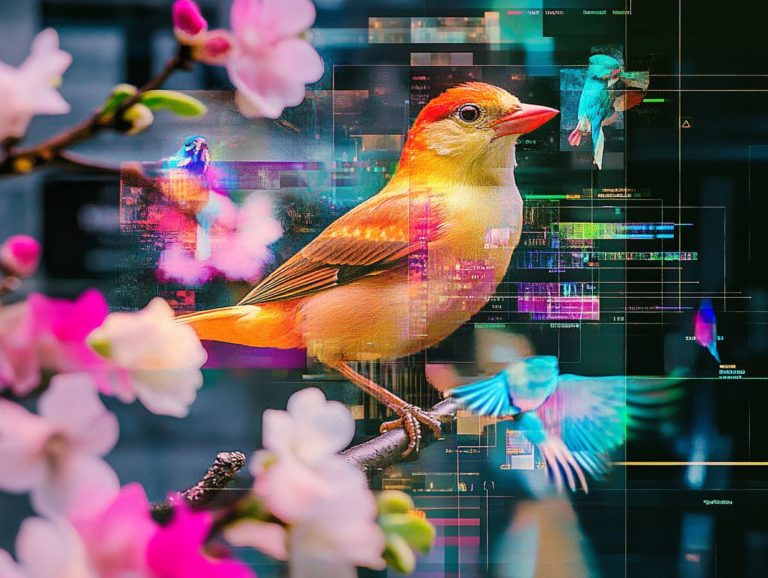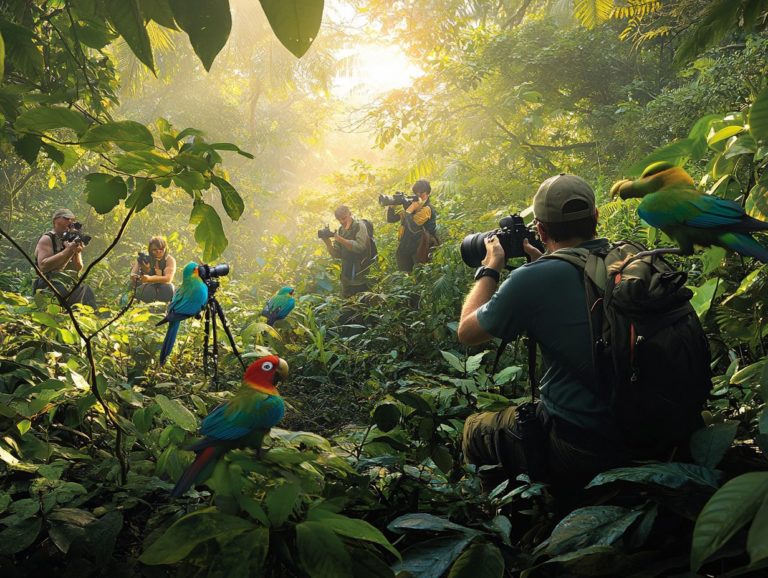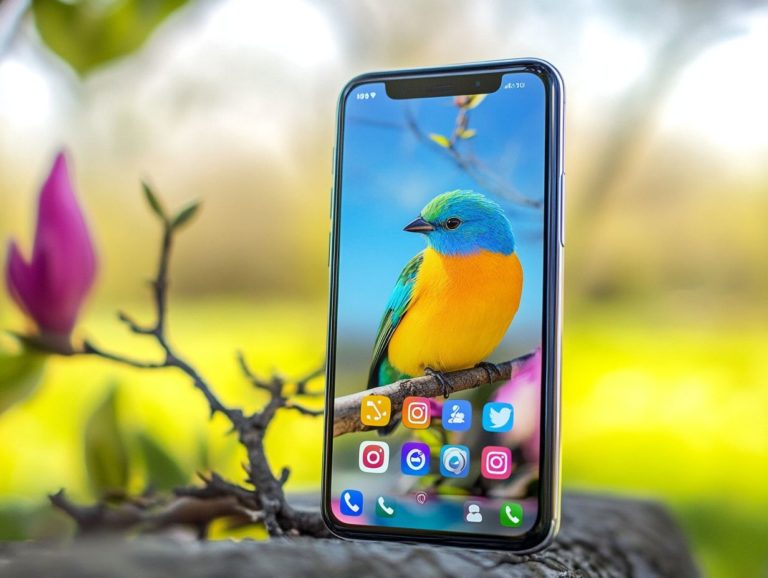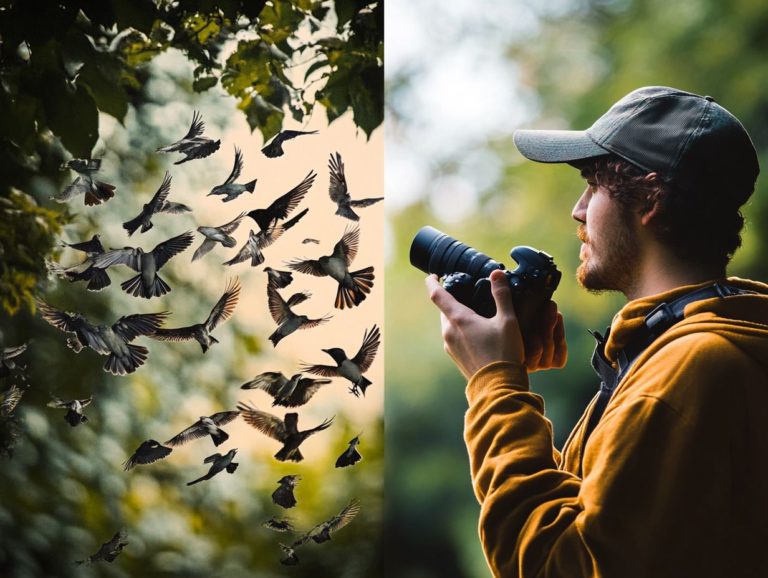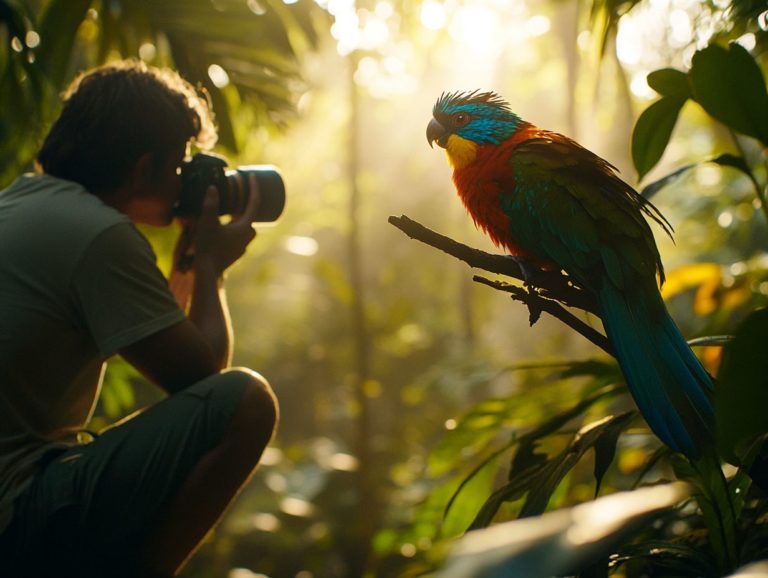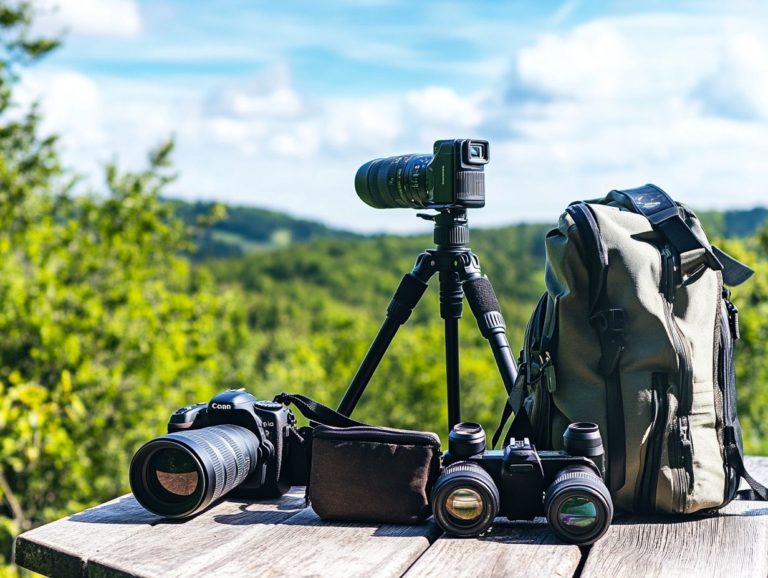How to Photograph Birds at Different Distances
Birdwatching and bird photography can be immensely fulfilling experiences. Understanding bird behavior in relation to distance is essential for capturing breathtaking images.
This article explores how varying distances influence bird reactions and outlines the optimal equipment for different scenarios. You ll also find valuable tips on lighting, composition, and timing, all designed to elevate your bird photography skills.
Whether you re just starting out or you ve been honing your craft for years, you ll uncover insights that will enhance both your skills and your appreciation for these captivating creatures.
Contents
- Key Takeaways:
- Understanding Bird Behavior and Distance
- Equipment for Photographing Birds at Different Distances
- Techniques for Photographing Birds at Close Range
- Techniques for Photographing Birds at Medium Range
- Techniques for Photographing Birds at Long Range
- Tips for Capturing the Best Shots
- Frequently Asked Questions
- What are some tips for photographing birds at different distances?
- What are the best camera settings for photographing birds at different distances?
- What is the best time of day to photograph birds at different distances?
- What are some common mistakes to avoid when photographing birds at different distances?
- Can I use a smartphone to photograph birds at different distances?
- How can I improve my composition when photographing birds at different distances?
Key Takeaways:
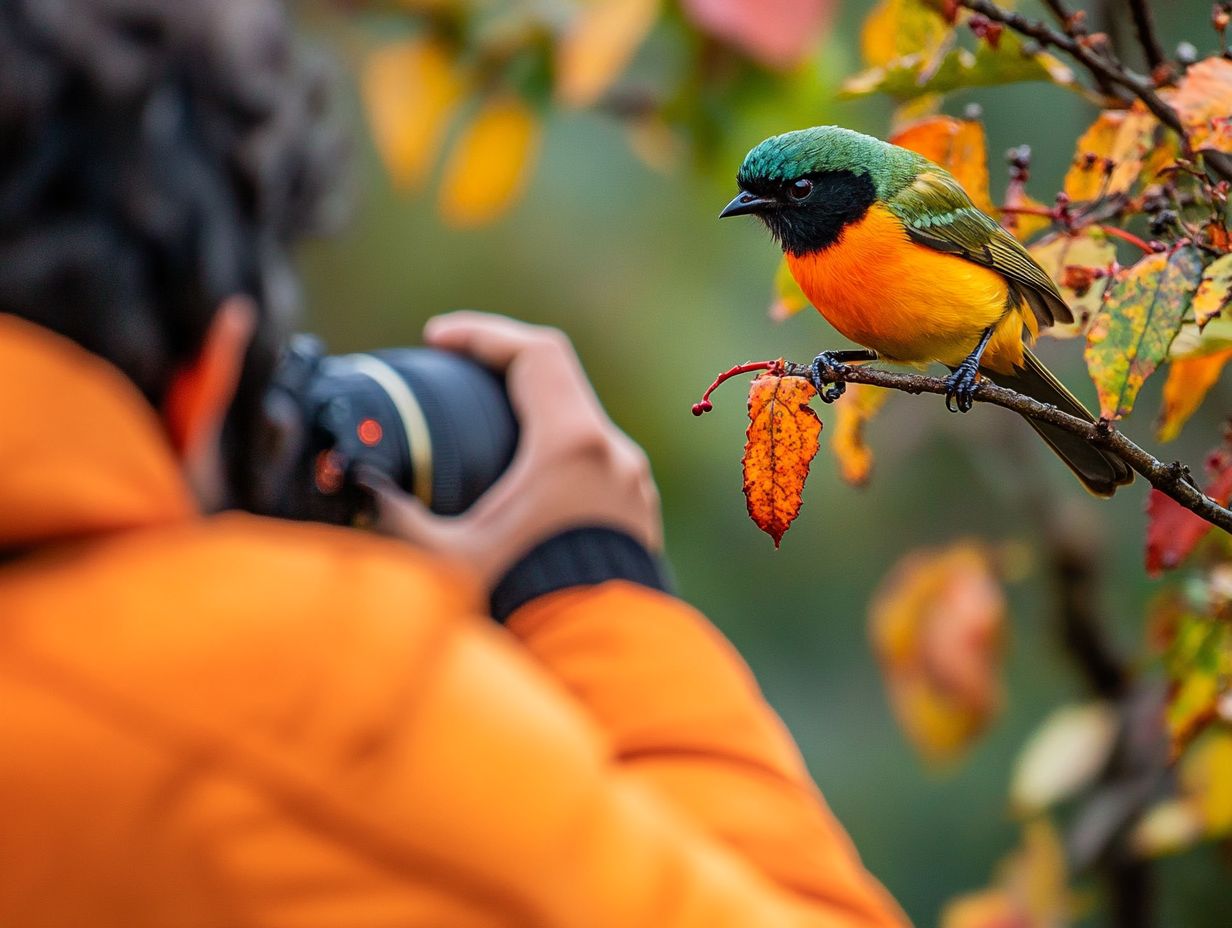
- Understand bird behavior and how they react to different distances to prepare for photography.
- Invest in the right equipment, such as recommended cameras and lenses, for optimal results.
- Utilize techniques like camouflage, patience, and the right lenses for capturing birds.
Understanding Bird Behavior and Distance
Understanding bird behavior and how distance affects behavior is essential for achieving excellence in bird photography. This is particularly important in diverse landscapes like Africa, Kenya, and Tanzania, where numerous bird species respond uniquely to proximity.
By observing these birds at varying distances, you can plan your birding excursions with greater precision. This ensures you’re fully prepared to capture breathtaking images, especially when you learn how to photograph birds with different backgrounds.
Wildlife photography demands both patience and a solid understanding of the terrain. Knowledge of key locations like the London Wetland Centre and Kruger National Park enhances your experience, as avian activities can fluctuate significantly.
How Birds React to Different Distances
Birds exhibit distinct behaviors depending on their distance from humans. Factors like species and habitat play pivotal roles in wildlife photography, especially when learning how to photograph birds at dusk.
For example, species such as the Eastern Bluebird tend to remain calm and approachable, allowing you to capture stunning images up close. In contrast, more skittish birds like the American Woodcock usually require a respectable distance to feel at ease.
This insight gives you the power to position yourself strategically, selecting vantage points that align seamlessly with the birds comfort zones.
Recognizing these nuances will enhance your birdwatching sessions, ensuring minimal disturbance while maximizing your chances of capturing compelling images. Choosing the right birding locations, especially those rich in suitable habitats, significantly enhances your opportunities to observe various species in their natural behaviors, ultimately elevating the quality of your photographic endeavors.
Equipment for Photographing Birds at Different Distances
The right equipment is crucial for capturing stunning bird photographs at various distances. Understanding focal length in bird photography, along with your choice of camera settings and long lenses, can dramatically influence the quality of your images.
High-performance camera bodies, such as the Nikon D850 or Canon EOS, empower you to seize breathtaking shots of birds in flight or perched nearby. Selecting appropriate photography gear, including lenses that excel in low-light conditions and offer impressive burst shooting capabilities, is essential for achieving successful action shots in any birding environment you encounter.
Recommended Cameras and Lenses
For your bird photography pursuits, consider cameras like the Nikon D850 or Canon EOS models. These options stand out due to their great image stabilization and autofocus systems. This greatly enhances your ability to capture sharp images, even in less-than-ideal conditions.
These camera bodies excel in continuous autofocus capabilities. This enables you to track fast-moving subjects with impressive precision. Use the back button focus technique, which allows you to control focus without adjusting your grip. This way, you can enhance your handling of action shots!
To further elevate your photography, invest in high-quality wildlife lenses. These lenses typically feature:
- Faster apertures
- Enhanced zoom capabilities
This provides you with a distinct advantage in any scenario. If purchasing outright feels daunting, lens rental services present a cost-effective solution. You can experiment with various focal lengths to find the right choice for each unique shooting environment.
Techniques for Photographing Birds at Close Range
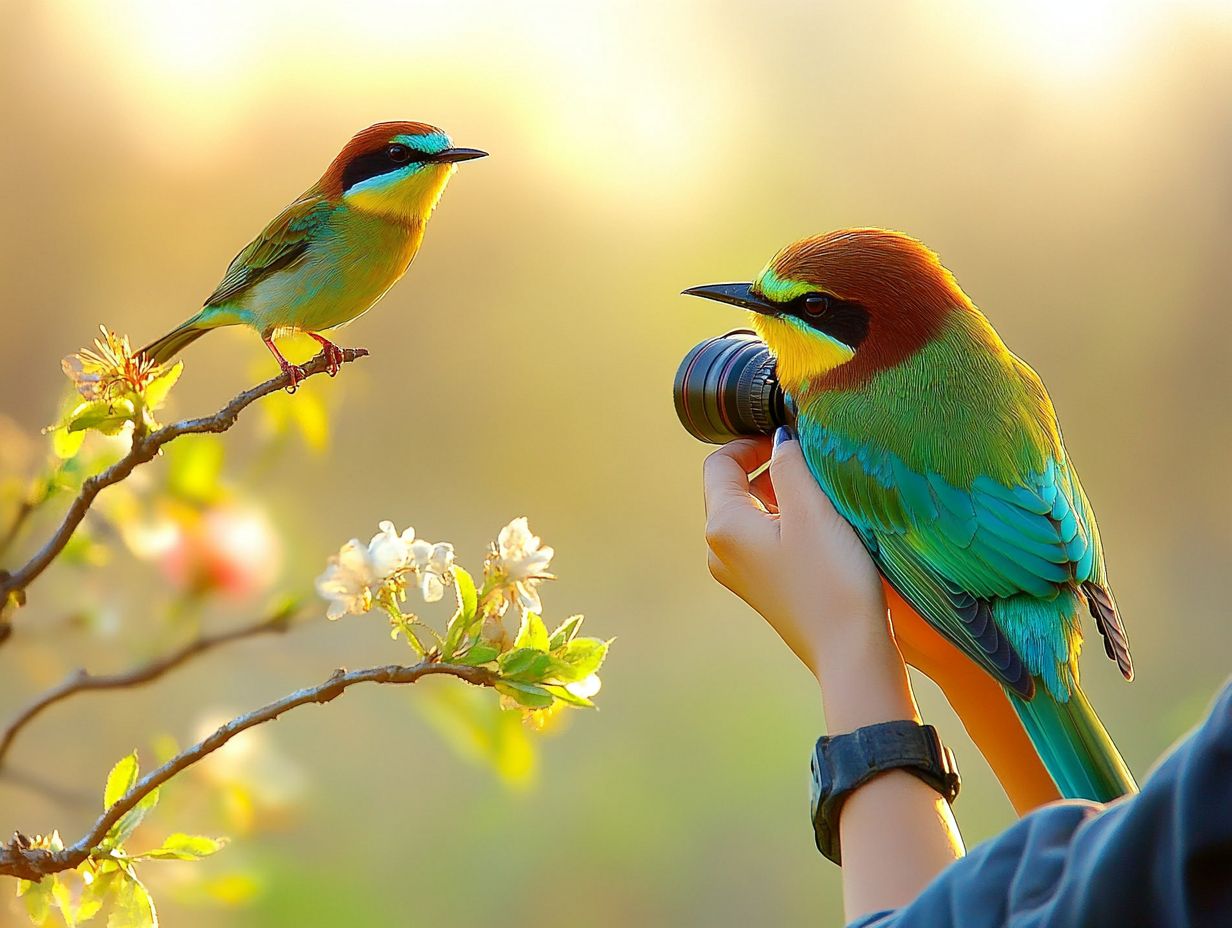
Photographing birds up close offers you a world of unique opportunities and challenges. By employing techniques like camouflage and cultivating patience, you can capture breathtaking portrait photography that truly reflects the essence of these magnificent creatures.
Using Camouflage and Patience
Camouflage in bird photography dramatically enhances your chances of successful wildlife encounters. It allows you to blend into your surroundings and observe birds without raising alarm.
Capture breathtaking close-up shots by adopting a patient approach. Take your time to remain still and quiet in your chosen spot. Specific camouflage techniques, such as wearing natural-toned clothing or using a hide, can significantly improve your ability to go unnoticed.
Investing in high-quality gear, like a versatile telephoto lens, enables you to capture detailed images without disturbing the birds’ natural behavior.
Position yourself strategically at known feeding or nesting sites. This not only increases the likelihood of encounters but also elevates the overall experience, making every moment spent waiting truly worthwhile!
Techniques for Photographing Birds at Medium Range
When photographing birds at medium range, employing techniques with telephoto lenses and tripods is essential for amazing results! To enhance your birdwatching experience, consider learning how to spot birds from a distance. These tools allow you to capture high-quality action shots while maintaining impeccable image clarity.
Using Telephoto Lenses and Tripods
Telephoto lenses are your secret weapon in bird photography, especially at medium range. They let you capture those intricate details while keeping a respectful distance from your feathered subjects. To get the most out of your shots, consider understanding exposure for bird photography.
These specialized lenses offer impressive magnification, which is essential for isolating wildlife from their surroundings. To achieve that sharp, crisp image, pay close attention to a few key factors. Understand elements like:
- Focal length
- Aperture size
- Image stabilization features
Using a sturdy tripod is crucial as it helps mitigate camera shake especially in lower light conditions where longer exposure times are needed. Adjusting the ISO, aperture, and shutter speed can significantly elevate the quality of your shots across various lighting scenarios. This ultimately results in stunning, dynamic images of avian life!
Techniques for Photographing Birds at Long Range
Photographing birds from a distance requires the application of specialized techniques. For those interested in learning more, check out this guide on how to safely photograph birds in the wild. Employing super telephoto lenses, paired with robust tripods, is essential for capturing clear, high-quality images of elusive wildlife.
Get ready to capture stunning images of birds like never before!
Using Super Telephoto Lenses and Tripods
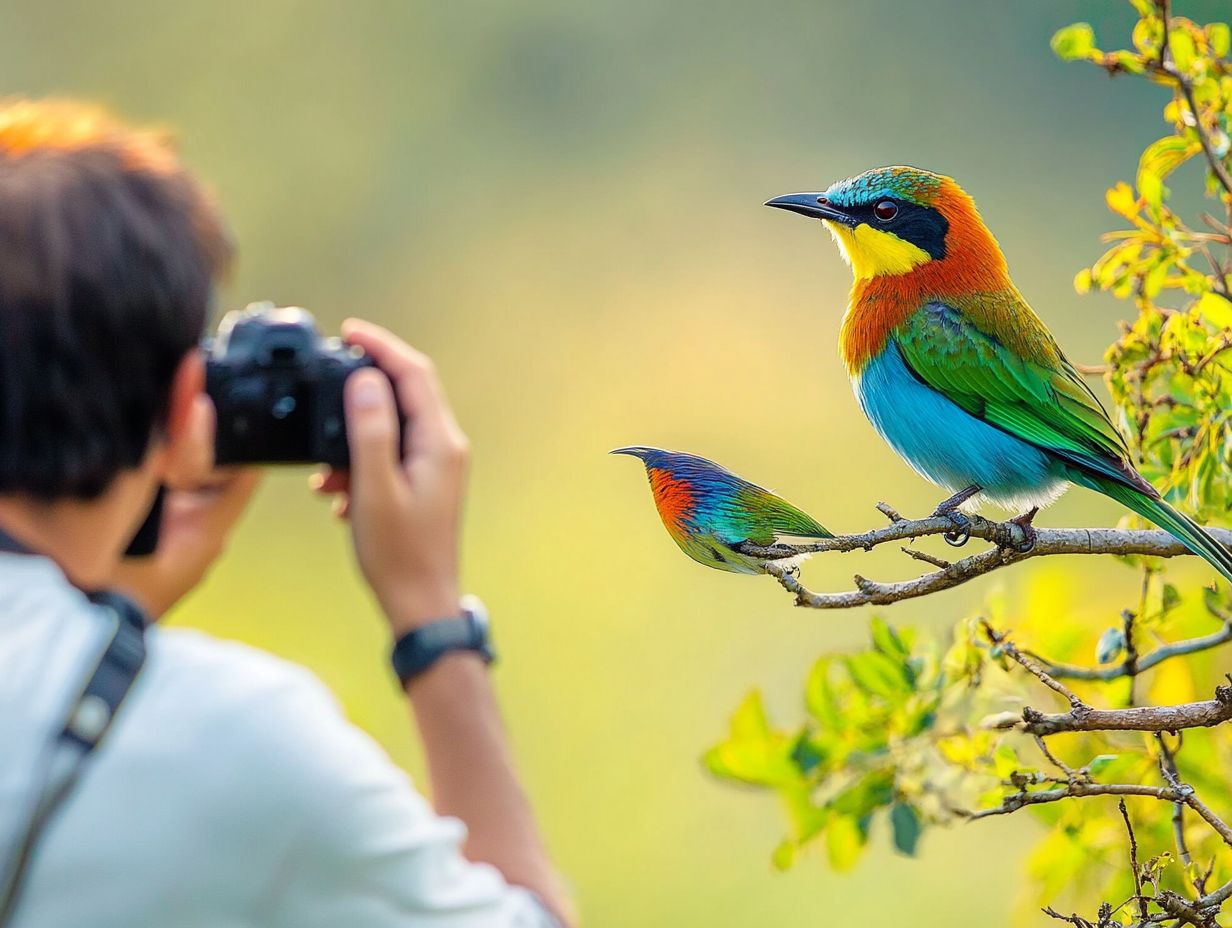
Super telephoto lenses are essential for photographing distant birds. They enable you to focus intently on your subjects while minimizing camera shake with effective image stabilization.
These lenses unlock a realm of possibilities, allowing you to frame stunning images of elusive creatures without intruding on their natural habitats. When choosing a super telephoto lens, carefully consider factors like focal length, aperture (the size of the lens opening), and compatibility with your camera body.
Using a sturdy tripod provides the stability necessary to maintain sharp images, particularly during longer exposures.
Adjusting your camera settings such as increasing the ISO (sensitivity to light) for improved low-light performance, employing a fast shutter speed to freeze motion, and experimenting with different apertures can further elevate the quality of your long-range shots. Paying attention to detail allows you to create stunning images that genuinely capture the beauty of wildlife.
Tips for Capturing the Best Shots
To capture great bird photos, master lighting, composition, and timing. This mastery, combined with advanced photography techniques and sophisticated editing software, will elevate your work to new heights.
Lighting, Composition, and Timing
Master effective lighting, composition, and timing to transform your bird photography into stunning art! Understanding how different lighting conditions influence the appearance of birds is essential for your craft.
For example, the enchanting glow of golden hour light can highlight feathers beautifully, breathing life into your subjects. Applying composition techniques, such as the rule of thirds, helps guide the viewer’s eye to focal points while maintaining a harmonious balance within the frame.
Timing is crucial! Stay observant and be patient to capture those breathtaking moments when birds take flight or engage in courtship behaviors.
By blending these elements, you can elevate the quality of your bird photographs, transforming them into captivating works of art.
Frequently Asked Questions
What are some tips for photographing birds at different distances?
1. Use a telephoto lens: A telephoto lens will allow you to get closer to the birds even from a distance, making it easier to capture clear and detailed shots. For more tips, check out these techniques for photographing birds in flight.
2. Adjust your camera settings: Make sure to adjust your aperture, shutter speed, and ISO according to the distance and lighting conditions to get the best results.
3. Use a tripod: A tripod will help stabilize your camera and prevent blurry images, especially when photographing birds at longer distances.
4. Get down to eye level: To capture more intimate shots of birds, try getting down to their eye level. This will create a more engaging and natural perspective.
5. Use a remote shutter release: This allows you to take photos without physically touching the camera, minimizing any potential disturbances and getting more natural shots.
6. Keep your distance: While it’s important to get close enough to the birds, make sure to maintain a safe distance to avoid disturbing them or their natural behavior.
What are the best camera settings for photographing birds at different distances?
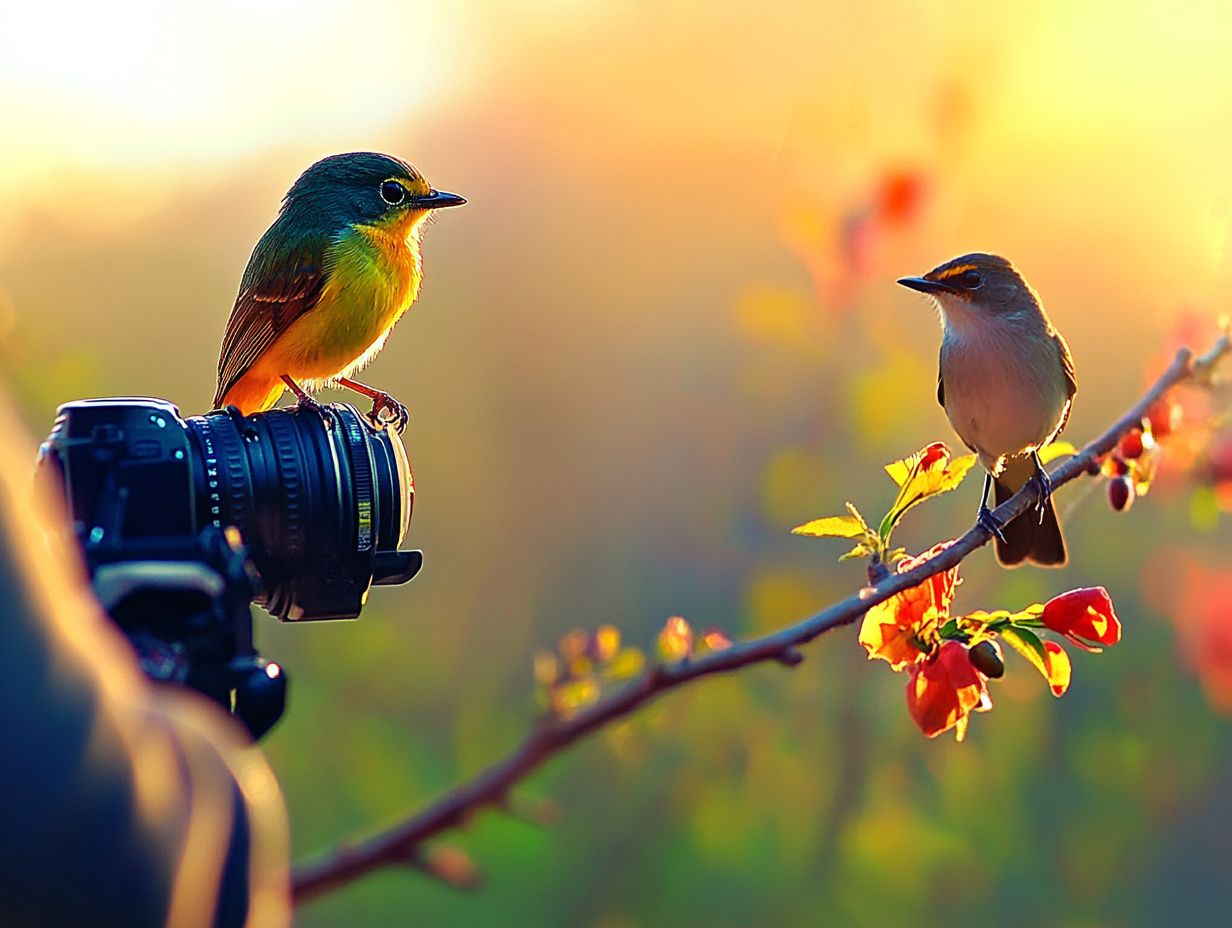
The ideal camera settings for photographing birds at different distances will vary depending on lighting conditions, distance, and the type of bird. A good starting point is to use a fast shutter speed (1/1000 or higher) to freeze movement, a low aperture (f/5.6 or lower) to create a shallow depth of field, and a low ISO (100-400) to reduce noise. For specific tips for photographing rare bird species, experimenting with different settings will help you find the perfect balance for each shot.
What is the best time of day to photograph birds at different distances?
The best time of day to photograph birds is during the golden hours: the first and last hours of sunlight. The light is softer and warmer, creating a more flattering look for your photos. During these times, birds tend to be more active, making it easier to capture dynamic shots.
What are some common mistakes to avoid when photographing birds at different distances?
1. Not researching the birds: Researching the birds you want to photograph helps you understand their behavior, habitat, and patterns, which can assist you in getting closer.
2. Not being patient: Birds can be unpredictable and may take time to appear. Be patient. Wait for the right moment to take your shot.
3. Not using appropriate gear: Using unsuitable gear can result in low-quality images. Use a long lens that allows you to zoom in on the birds without getting too close, and a camera with good autofocus and burst mode.
4. Not paying attention to the background: A cluttered background can distract from your subject. Be mindful of your background to get a clean, unobstructed shot.
5. Not respecting the birds: Always respect the birds and their space! This ensures you get the best shots without disturbing them.
Can I use a smartphone to photograph birds at different distances?
While smartphones have improved in terms of camera quality, they may not be the best option for photographing birds. The small sensor and limited zoom can result in lower quality images. It’s recommended to use a dedicated camera with a long lens for better results.
How can I improve my composition when photographing birds at different distances?
1. Use the rule of thirds: Divide your frame into thirds both horizontally and vertically. Place your subject at the intersection of the lines for a more balanced composition.
2. Experiment with different angles: Instead of just shooting straight on, try various angles to add depth and interest.
3. Include the surroundings: Adding elements from the bird’s habitat can provide context and tell a more complete story.
4. Use negative space: Negative space can help draw attention to your subject and create a minimalist composition.
5. Practice patience: Take your time to observe the birds and their movements. Wait for the right moment to capture your shot. What unique angles have you tried? Share your experiences!

